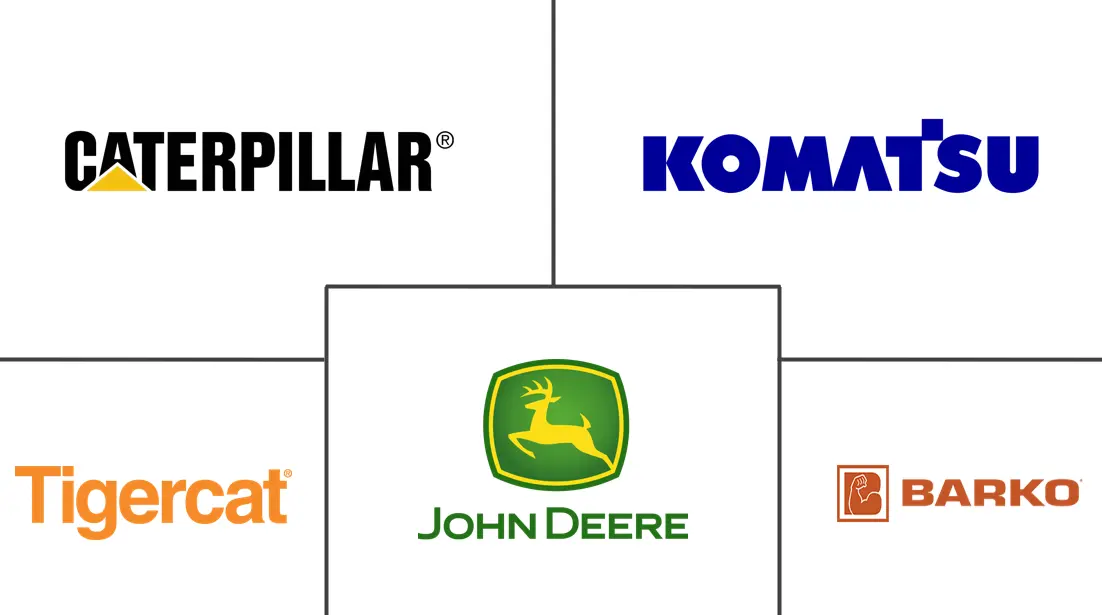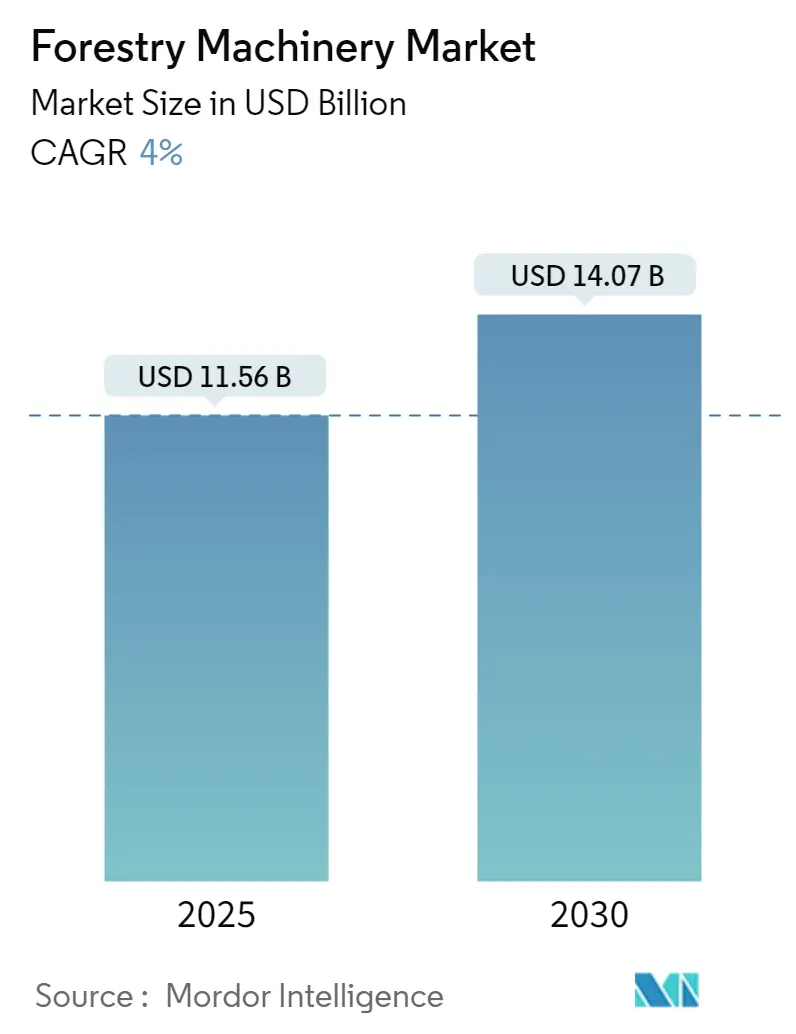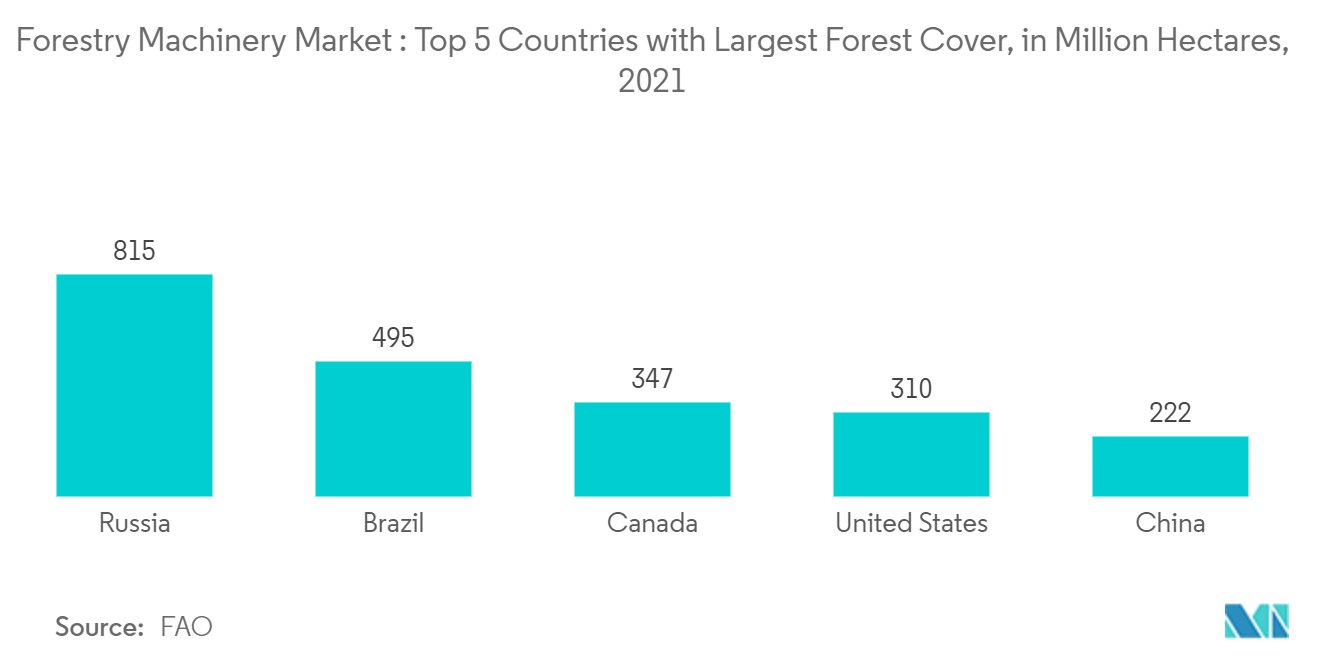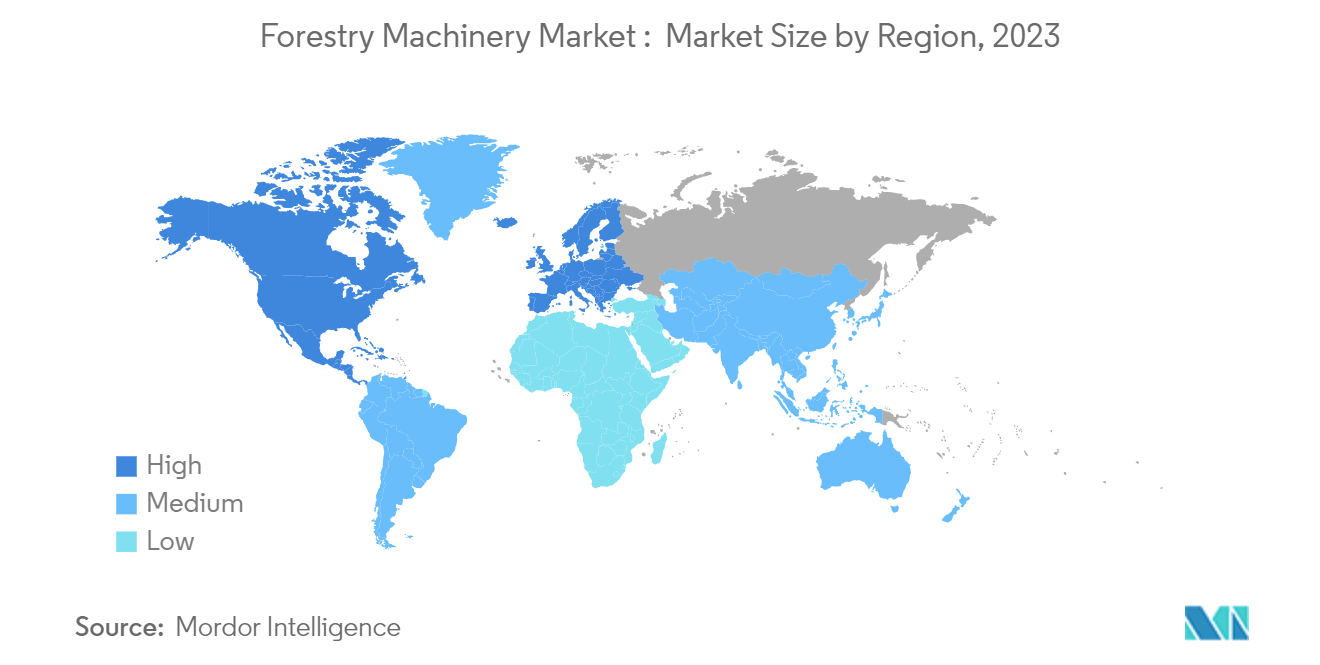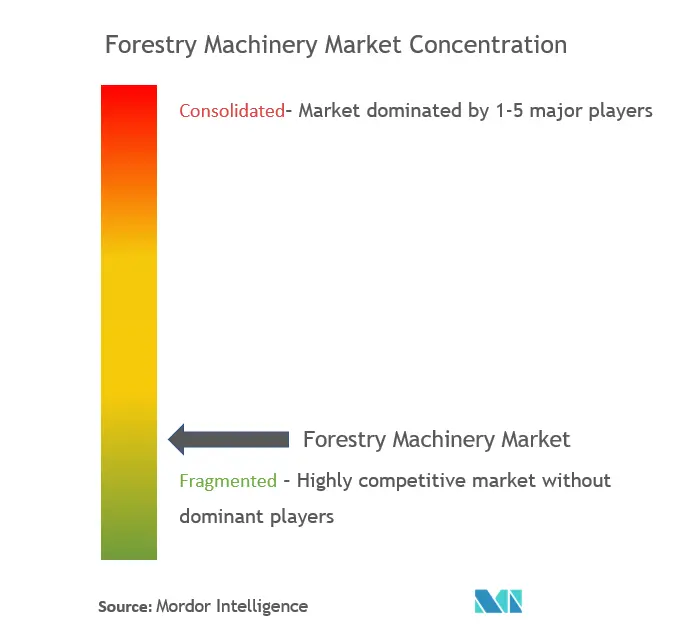Forestry Machinery Market Analysis
The Forestry Machinery Market size is estimated at USD 11.56 billion in 2025, and is expected to reach USD 14.07 billion by 2030, at a CAGR of 4% during the forecast period (2025-2030).
The forest machinery market is steadily growing, fueled by a rising awareness of sustainable forest management and an increasing demand for wood-based products. These machines, essential for logging, thinning, and harvesting, are pivotal in maximizing productivity while minimizing environmental impact. The surging demand for timber, paper, and wood products worldwide shows huge opportunities for forest machinery manufacturers. Technological innovations, such as enhanced engine efficiency and lower emissions, also bolster market growth. For instance, Ponsse launched the EV1 in September 2022, the first fully electric forwarder. Operating solely on battery power, the EV1 boasts zero emissions, underscoring a significant stride toward sustainability in forestry machinery and aiming to curtail the carbon footprint of logging and forest management.
A major driver for the market’s growth is the incorporation of GPS and telematics systems into forestry equipment. These advancements facilitate real-time tracking, precision harvesting, and heightened operational efficiency, steering forest management toward sustainability. For instance, in April 2021, Tigercat enhanced the features of its robust RemoteLog and LogOn telematics system. Such upgrades empower operators to fine-tune harvesting precision and boost machine efficiency, leading to reduced fuel consumption and a diminished environmental footprint. North America and Europe lead in embracing such cutting-edge equipment, largely due to the surging demand for wood pallets in power plant fuel. Such trends in these regions align with a broader emphasis on renewable energy and sustainable forest management.
Amid the growing market trend, the United States produced around 1,197 billion cubic feet of industrial roundwood in 2021, according to the US Forest Service. Such substantial output underscores the increasing dependence on advanced forest machinery to cater to the surging demand for wood products. As industrial roundwood production increases, the necessity for efficient equipment becomes more critical to streamline large-scale logging operations, curb labor costs, and boost productivity. With the rise in demand for wood-based products, the forestry machinery market is projected to grow further in the coming years, fueled by continuous technological advancements.
Forestry Machinery Market Trends
Increasing Mechanization in Forestry Machinery
Factors such as rising mechanization rates in the logging industries of developing nations and the increasing use of cut-to-length logging techniques, which are more machine-intensive, in industrialized countries are also contributing to the market’s growth. Countries with the highest forest cover are some of the most potent markets for forestry machinery, and Russia has the highest forest cover. According to the World Bank's statistics, Russia has a forest cover spanning approximately 49% of the country’s total land area.
According to the European Commission, 550 million solid cubic meters of roundwood were harvested in 2021 in Europe. Wood extraction is carried out using various methods and levels of mechanization, including motor manual, semi-mechanized, and fully mechanized techniques. In Sweden, registration of forwarders rose by over 50% in 2023 compared to the previous year, with more than 400 machines sold. For instance, John Deere, the leading company in the market, maintained its top position and registered 168 forwarders in Sweden in 2023. However, Komatsu, its main competitor, made a significant leap by increasing its sales the most.
The manufacturing of wood products by harvesting forest wood is one of the most profitable forestry industries, and it contributes significantly to various industries in many countries with high forest cover. To improve productivity, dependence on mechanized methods for forest harvesting has increased steadily over the years. High-performance equipment, such as harvesters, can cut a tree from the base, debark it, and cut it into the required lengths within a minute. Automation is expected to aid in new dimensions in the forest industry in the coming years by making tasks easy, productive, and efficient and achieving the desired result. Forest mechanization can potentially increase the penetration of forest equipment, thus boosting the market during the forecast period.
Europe Dominates the Market
Europe is one of the world's most forested regions, with 182 million ha of forest, covering 43% of its total land area in 2023, according to the Eurostat. The growing focus on forest activities, significant advancements in logging techniques, and progress in forest science to enhance operations like reducing the risk of fires and implementing sustainable harvesting practices are projected to stimulate market growth.
Governments and international organizations have put in place more stringent environmental rules and regulations to encourage the sustainable management of forests. For instance, the European Union Timber Regulation (EUTR) prohibits the trade of illegally harvested wood. Equipment with advanced monitoring and tracking features helps ensure compliance with these regulations and increases the need for forest equipment. Thus, integrating GPS control systems into forestry equipment is a key factor in boosting production efficiency by enabling real-time tracking and sustainable operations, thereby driving significant growth in demand across Europe. Besides, European governments have implemented various programs to support forest areas, including financial support through the Common Agricultural Policy (CAP). Additionally, measures taken by European countries to fund forestry activities via national development programs continue to underpin the sales of forestry machinery in the region.
The surging demand for dependable, effective, and time-saving machinery for forestry activities has compelled manufacturers to develop new, efficient, and streamlined products. For instance, in 2022, John Deere introduced a new operator assistance control feature called Intelligent Boom Control (IBC) for the 900 MH-Series Tracked Harvester. This feature offers intuitive operator support, ensuring consistent and smooth operation during work. Hence, the forestry machinery market in Europe is poised to experience substantial growth in the coming years due to an increasing need for mechanized forest activities, along with government support and new product launches by leading companies.
Forestry Machinery Industry Overview
The forestry machinery market is fragmented with major companies such as Deere & Company, Komatsu, Barko Hydraulics LLC, Caterpillar Inc., and Tigercat International Inc., despite their diverse and expanding product portfolios. In the fast-growing forestry machinery market, companies are competing based on product quality or product promotion and focusing on other strategic moves to acquire a larger share and expand their acquired market size.
Forestry Machinery Market Leaders
-
Deere & Company
-
Komatsu Forest
-
Barko Hydraulics L.L.C.
-
Caterpillar, Inc.
-
Tigercat International Inc
- *Disclaimer: Major Players sorted in no particular order
Forestry Machinery Market News
- November 2023: FAE launched the BLO EX Forestry Mulcher, designed for 2 to 4-metric tons excavators, offering compact yet powerful mulching capabilities for forest management and land clearing. By expanding its product portfolio to include lightweight and versatile equipment, FAE strengthened its competitive position in the market.
- September 2022: Komatsu launched a swing machine for timber processing. Komatsu's new PC230F-11 forestry processor is designed for heavy-duty timber delimbing, cutting, and stacking operations. This powerful swing system and a giant circle can move large trees more easily.
- May 2022: John Deere launched the latest operator assistance control feature, Intelligent Boom Control (IBC), for the 900 MH-Series Tracked Harvester. Intelligent Boom Control provides intuitive operator assistance by providing consistent and smooth operation on the job.
Forestry Machinery Industry Segmentation
Forestry machinery is a machine and power-driven equipment that aids in excavating, harvesting, and finishing a wooded area. The forestry machinery market is segmented by machinery into skidders, forwarders, swing machines, bunchers, harvesters, loaders, and other forestry machinery. By geography, it is segmented into North America, Europe, Asia-Pacific, South America, and Middle East and Africa. The report offers market sizing and forecasts in value (USD) for all the above segments.
| Machine Type | Skidders | ||
| Forwarders | |||
| Bunchers | |||
| Swing Machines | |||
| Harvesters | |||
| Loaders | |||
| Other Forestry Machinery | |||
| Geography | North America | United States | |
| Canada | |||
| Mexico | |||
| Rest of North America | |||
| Europe | Germany | ||
| United Kingdom | |||
| France | |||
| Russia | |||
| Spain | |||
| Sweden | |||
| Finland | |||
| Rest of Europe | |||
| Asia-Pacific | China | ||
| Japan | |||
| India | |||
| South Korea | |||
| Rest of Asia-Pacific | |||
| South America | Brazil | ||
| Argentina | |||
| Rest of South America | |||
| Middle East and Africa | South Africa | ||
| Rest of Middle East and Africa | |||
Forestry Machinery Market Research FAQs
How big is the Forestry Machinery Market?
The Forestry Machinery Market size is expected to reach USD 11.56 billion in 2025 and grow at a CAGR of 4% to reach USD 14.07 billion by 2030.
What is the current Forestry Machinery Market size?
In 2025, the Forestry Machinery Market size is expected to reach USD 11.56 billion.
Who are the key players in Forestry Machinery Market?
Deere & Company, Komatsu Forest, Barko Hydraulics L.L.C., Caterpillar, Inc. and Tigercat International Inc are the major companies operating in the Forestry Machinery Market.
Which is the fastest growing region in Forestry Machinery Market?
Asia-Pacific is estimated to grow at the highest CAGR over the forecast period (2025-2030).
Which region has the biggest share in Forestry Machinery Market?
In 2025, the Europe accounts for the largest market share in Forestry Machinery Market.
What years does this Forestry Machinery Market cover, and what was the market size in 2024?
In 2024, the Forestry Machinery Market size was estimated at USD 11.10 billion. The report covers the Forestry Machinery Market historical market size for years: 2019, 2020, 2021, 2022, 2023 and 2024. The report also forecasts the Forestry Machinery Market size for years: 2025, 2026, 2027, 2028, 2029 and 2030.
Our Best Selling Reports
Forestry Machinery Industry Report
Statistics for the 2025 Forestry Machinery market share, size and revenue growth rate, created by Mordor Intelligence™ Industry Reports. Forestry Machinery analysis includes a market forecast outlook for 2025 to 2030 and historical overview. Get a sample of this industry analysis as a free report PDF download.

